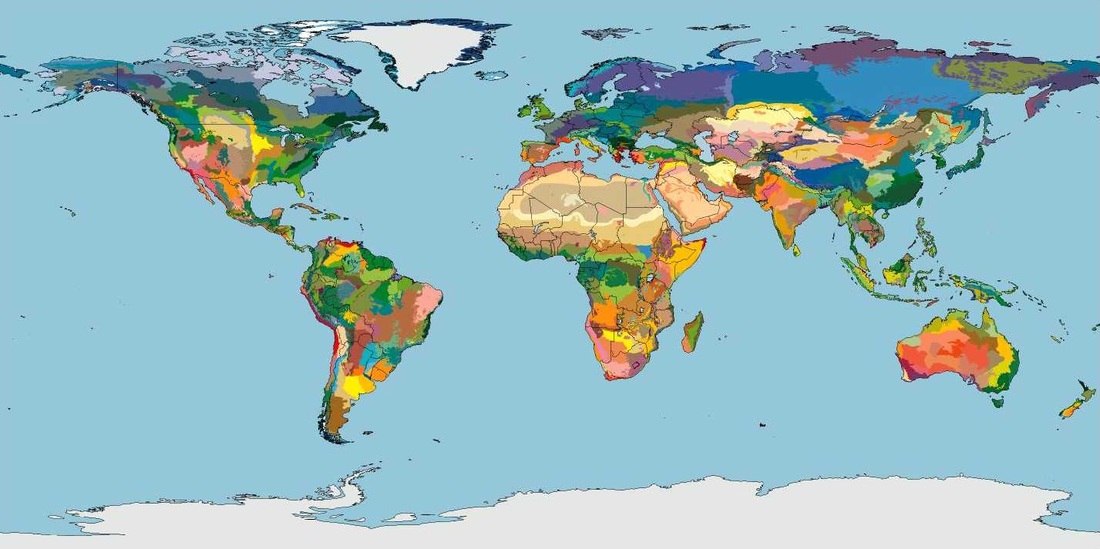Introduction
The Neotropic is one of the eight terrestrial biogeographic realms defined by Udvardy (1975), and includes South America, Central America, the southern and lower regions of Mexico and the Caribbean Islands. Olson et al., (2001), further divided the realm into nearly 180 ecoregions and 11 biomes that arise from the grouping of these ecoregions and that reflect the distribution of many groups of fauna and flora (figure 1). It is one of the main reservoirs of biodiversity in the world, and according to Olson et al., (2001), it has one of the three richest mammal assemblages in the world and some of its ecoregions are one of the richest in number of endemic species.
Although there are other classifications of ecosystems (see Sayre et al., 2014), the one proposed by Olson et al, still seems to be very well supported since it is based on the actual distribution of species and communities, product of the effort of many field researchers and regional experts, and it’s not merely based on the division of biophysical features (such as temperature or precipitation) or its overlaying over landforms or land uses.
The Neotropic is one of the eight terrestrial biogeographic realms defined by Udvardy (1975), and includes South America, Central America, the southern and lower regions of Mexico and the Caribbean Islands. Olson et al., (2001), further divided the realm into nearly 180 ecoregions and 11 biomes that arise from the grouping of these ecoregions and that reflect the distribution of many groups of fauna and flora (figure 1). It is one of the main reservoirs of biodiversity in the world, and according to Olson et al., (2001), it has one of the three richest mammal assemblages in the world and some of its ecoregions are one of the richest in number of endemic species.
Although there are other classifications of ecosystems (see Sayre et al., 2014), the one proposed by Olson et al, still seems to be very well supported since it is based on the actual distribution of species and communities, product of the effort of many field researchers and regional experts, and it’s not merely based on the division of biophysical features (such as temperature or precipitation) or its overlaying over landforms or land uses.
Figure 1. Terrestrial ecosystems of the world. From Olson et al., 2001.
This great diversity of ecosystems and biomes is clearly related to the weather patterns along the Neotropic. The cool and rainy conditions in the central mountain ranges of Mexico have originated many types of coniferous forests. The warmer and rainy conditions that go from the South of Mexico to the Amazonas have originated a great diversity of Tropical Forests. Along the Atlantic coast of Brazil, dryer conditions have originated ecosystems such as deserts and savannas. In Chile and Argentina, the climate and ecosystems go from deserts in the north, cold mountains on the Andes, to Antarctic conditions at Tierra del Fuego on the tip of the continent (Oliver, 2005).
However, climate change represents a threat to these climates and biomes. For the year 2013, there have been already some observed changes in climate (Figure 2). Temperature has increased mostly in the northern parts of Mexico and Brazil, while there have been some decreases in temperature in some regions near the Andes. For precipitation, the most affected zones have been the northern regions of Mexico, and the east coast of Brazil. According to a climate projection using an ensemble of 15 atmosphere-ocean coupled general circulations models (AOGCMS), temperature will rise 1.9° C for the year 2050 for Mexico and Central America, and 2.02° C for South America. Precipitation will decrease 2.14% in Mexico, while in South America will vary geographically, most notably showing a reduction of 18% in most of Brazil, and an increase of 24% in Southeast South America.
However, climate change represents a threat to these climates and biomes. For the year 2013, there have been already some observed changes in climate (Figure 2). Temperature has increased mostly in the northern parts of Mexico and Brazil, while there have been some decreases in temperature in some regions near the Andes. For precipitation, the most affected zones have been the northern regions of Mexico, and the east coast of Brazil. According to a climate projection using an ensemble of 15 atmosphere-ocean coupled general circulations models (AOGCMS), temperature will rise 1.9° C for the year 2050 for Mexico and Central America, and 2.02° C for South America. Precipitation will decrease 2.14% in Mexico, while in South America will vary geographically, most notably showing a reduction of 18% in most of Brazil, and an increase of 24% in Southeast South America.
Figure 2. Observed and projected changes in temperature and precipitation for the Neotropic.
Given that these changes in the weather
patterns are homogeneous neither throughout the Neotropic nor throughout the
year, it is important to identify the regions and seasons with the more drastic
changes. In the same way, it is important to determine how this spatial and
temporal variation will affect the distribution of the biomes of the Neotropic.

